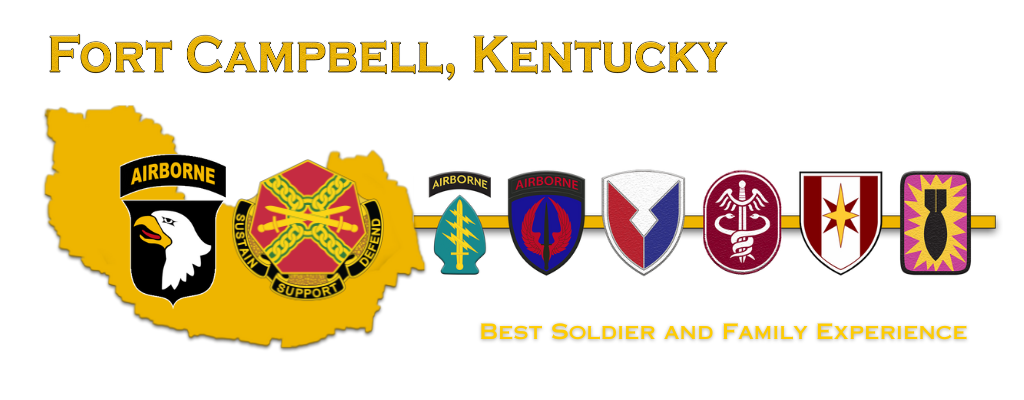
Top Secret
The military built Clarksville Base to keep the United States’ nuclear weapons stockpile secure. Everything about the design of the base created a high security environment. Security was the top priority and considered the job of everyone on the base. The layers of security may seem extreme now, but they were necessary. The Soviet Union sent agents from the KGB to try to get information about and possibly access to the base. The military used two types of security at Clarksville Base: physical security and personnel security.
Physical Security
Location
The first layer of physical security for Clarksville Base was its location within Fort Campbell. The Army installation provided a buffer between Clarksville Base and the outside world. It was also a source of additional defensive manpower if the base was ever attacked.
Perimeter Fence and Patrol Road
 Clarksville Base was separated from Fort Campbell by four eight-foot tall chain-link security fences. Each was topped by two strands of barbed wire. A narrow road located within the exterior fence encircled the entire base. Heavily armed Marines patrolled the road at regular intervals. A disturbance along any section of the fence triggered lights on tall poles to alert the Marines of a possible intruder. Three additional fences circled the base within the perimeter patrol road. The middle fence of the three was a high voltage electric fence. The perimeter fence systems also had audio alarms to warn guards that an intruder was trying to get inside.
Clarksville Base was separated from Fort Campbell by four eight-foot tall chain-link security fences. Each was topped by two strands of barbed wire. A narrow road located within the exterior fence encircled the entire base. Heavily armed Marines patrolled the road at regular intervals. A disturbance along any section of the fence triggered lights on tall poles to alert the Marines of a possible intruder. Three additional fences circled the base within the perimeter patrol road. The middle fence of the three was a high voltage electric fence. The perimeter fence systems also had audio alarms to warn guards that an intruder was trying to get inside.
Bridges over Little West Fork Creek
The perimeter patrol road for Clarksville Base crosses Little West Fork Creek in two places. Engineers built two bridges over the creek with special security measures designed to prevent an intruder from accessing the base. The bridges have metal roll down shutters that extend down to the water line to prevent access by boat.
Security within Clarksville Base
The storage facilities for the weapons had several layers of security. First, the bunkers were constructed using reinforced concrete that was up to 17 feet thick. They were built either entirely underground or covered with a deep layer of earth. Armed Marines in pillboxes (small concrete guardhouses) watched over the entrances to each storage bunker, which were secured with heavy blast doors. Inside the bunker, the tunnel to the storage rooms was secured with a metal cage-type door and a bank vault door. Additional bank vault doors secured the entrance to each weapons storage room.
Personnel Security
Secrecy
Clarksville Base was shrouded in secrecy. The workers at the base had just enough information to do their jobs, and they were not allowed to discuss their work with each other. Workers were told not to mention Clarksville Base or nuclear weapons at all when they left the base. Members of the Navy were told not to wear their uniforms when off the base, because Navy uniforms in a completely landlocked area of the country would have attracted too much attention. Those who did not follow the strict secrecy policy could be disciplined, transferred off the base, or prosecuted.
Security Clearance
 Civilians and members of the military working at Clarksville Base had either a “Q” or an “A” security clearance. “A” security clearance provided access to the administrative area of the base, which included the headquarters building, barracks, and other buildings that supported everyday life. “Q“ security clearance provided access to the area of Clarksville Base where nuclear weapons were stored. A “Q” clearance required an extensive FBI background check. When workers at Clarksville Base wanted to access a “Q” area, they had to go to the Identification Badge Exchange building and trade their “A” badge for a “Q” badge. Anyone in a “Q” area without the proper “Q” badge could be detained or shot by the Marines patrolling the base.
Civilians and members of the military working at Clarksville Base had either a “Q” or an “A” security clearance. “A” security clearance provided access to the administrative area of the base, which included the headquarters building, barracks, and other buildings that supported everyday life. “Q“ security clearance provided access to the area of Clarksville Base where nuclear weapons were stored. A “Q” clearance required an extensive FBI background check. When workers at Clarksville Base wanted to access a “Q” area, they had to go to the Identification Badge Exchange building and trade their “A” badge for a “Q” badge. Anyone in a “Q” area without the proper “Q” badge could be detained or shot by the Marines patrolling the base.
Secure Weapons Access
In order to make the nuclear weapons at Clarksville Base even more secure, the workers at the base used the Nuclear Release and Authorization System (NRAS). Under this system, both a military combination and a civilian combination were needed to unlock the bank vault doors that secured the storage bunkers. That way, the military could not use nuclear weapons without civilian approval.
Navigation
Welcome
People
Top Secret
Built For A Job
Stories
Looking Forward
Driving Tour Brochure
Further Research
✪ Discussion on concept of two-man control and other security measures
✪ Denotes an external link






